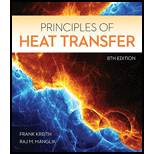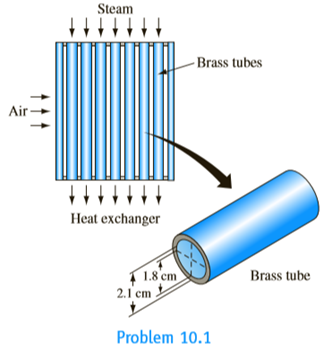
In a heat exchanger, as shown in the accompanying figure, air flows over brass tubes of 1.8-cm 1D and 2.1-cm OD containing steam. The convection heat transfer coefficients on the air and steam sides of the tubes are

(a)
The overall heat transfer coefficient based on the inner tube area.
Answer to Problem 10.1P
Over all heat transfer co-efficient based on inner surface area is
Explanation of Solution
Given information:
Inner diameter of the tube
Outer diameter of the tube
Air flows outside the tubes and steam flows inside the tubes.
Convective heat-transfer coefficients onair side and steam side are
From Appendix 2 (Table 10),
Thermal conductivity of brass
Part a:
Over all hear transfer co-efficient based on inner surface area.
Over all heat transfer co-efficient based on inner surface area is given by (refer to Equation 10.4 in text book)
(b)
Overall heat transfer coefficient based on outer surface area of the tube
Answer to Problem 10.1P
Overall heat transfer coefficient based on outer surface area of the tube is
Explanation of Solution
Overall heat transfer coefficient based on outer surface area of the tube is given by (refer to equation 10.3 in text book)
Overall heat transfer coefficient based on inner surface area is 50.36
Want to see more full solutions like this?
Chapter 10 Solutions
Principles of Heat Transfer (Activate Learning with these NEW titles from Engineering!)
- An Inclining experiment done on a ship thats 6500 t, a mass of 30t was moved 6.0 m transvesly causing a 30 cm deflection in a 6m pendulum, calculate the transverse meta centre height.arrow_forwarda ship 150 m long and 20.5 m beam floats at a draught of8 m and displaces 19 500 tonne. The TPC is 26.5 and midshipsection area coefficient 0.94. Calculate the block, prismatic andwaterplane area coefficients.arrow_forwardA vessel loads 680 t fuel between forward and aft deep tanks. centre of gravity of forward tank is 24m forward of ships COG. centre to centre between tanks is 42 m. how much in each tank to keep trim the samearrow_forward
- Beam of a vessel is 11% its length. Cw =0.72. When floating in SW of relative denisity 1.03, TPC is 0.35t greater than in freshwater. Find the length of the shiparrow_forwardAn inclining experiment was carried out on a ship of 4000tonne displacement, when masses of 6 tonne were moved transverselythrough 13.5 m. The deflections of a 7.5 m pendulurnwere 81, 78, 85, 83, 79, 82, 84 and 80 mm respectively.Caiculate the metacentric height.arrow_forwardA ship of 10 000 tonne displacement has a waterplanearea of 1300 m2. The ship loads in water of 1.010 t/m3 andmoves into water of 1.026 t/m3. Find the change in meandraughtarrow_forward
- A ship of 7000 tonne displacement has a waterplane areaof 1500 m2. In passing from sea water into river water of1005 kg/m3 there is an increase in draught of 10 cm. Find the Idensity of the sea water.arrow_forwardA ship has 300 tonne of cargo in the hold, 24 m forward ofmidships. The displacement of the vessel is 6000 tonne and its centre of gravity is 1.2 m forward of midships.Find the new position of the centre of gravity if this cargo ismoved to an after hold, 40 m from midshipsarrow_forwardSketch and describe how ships are supported in dry dock. When and where does the greatest amount of stresses occur?arrow_forward
- Sketch and desribe a balanced rudder and how it is suspendedarrow_forwardA ship 140 m long and 18 m beam floats at a draught of9 m. The immersed cross-sectionai areas at equai intervais are 5,60, 116, 145, 152, 153, 153, 151, 142, 85 and 0 m2 respectively.Calculate:(a) displacement(b) block coefficient(c) midship section area coefficient(d) prismatic coefficient.arrow_forwardA steamer has waterplane area 1680m2 recorded in water with relative denisty 1.013. Displacement = 1200 t, calculate difference in draught in salwater reltive denisity 1.025.arrow_forward
 Principles of Heat Transfer (Activate Learning wi...Mechanical EngineeringISBN:9781305387102Author:Kreith, Frank; Manglik, Raj M.Publisher:Cengage Learning
Principles of Heat Transfer (Activate Learning wi...Mechanical EngineeringISBN:9781305387102Author:Kreith, Frank; Manglik, Raj M.Publisher:Cengage Learning
